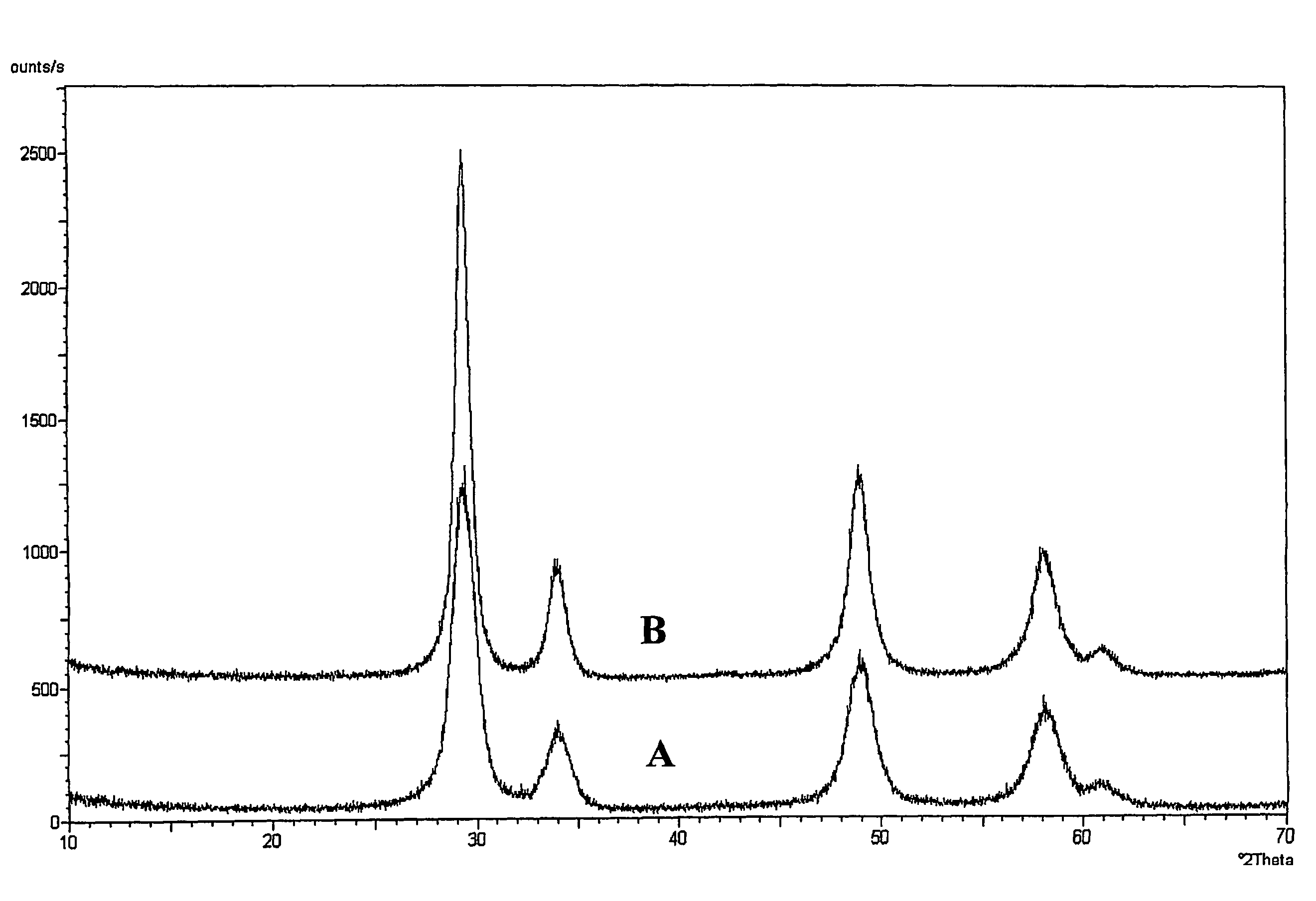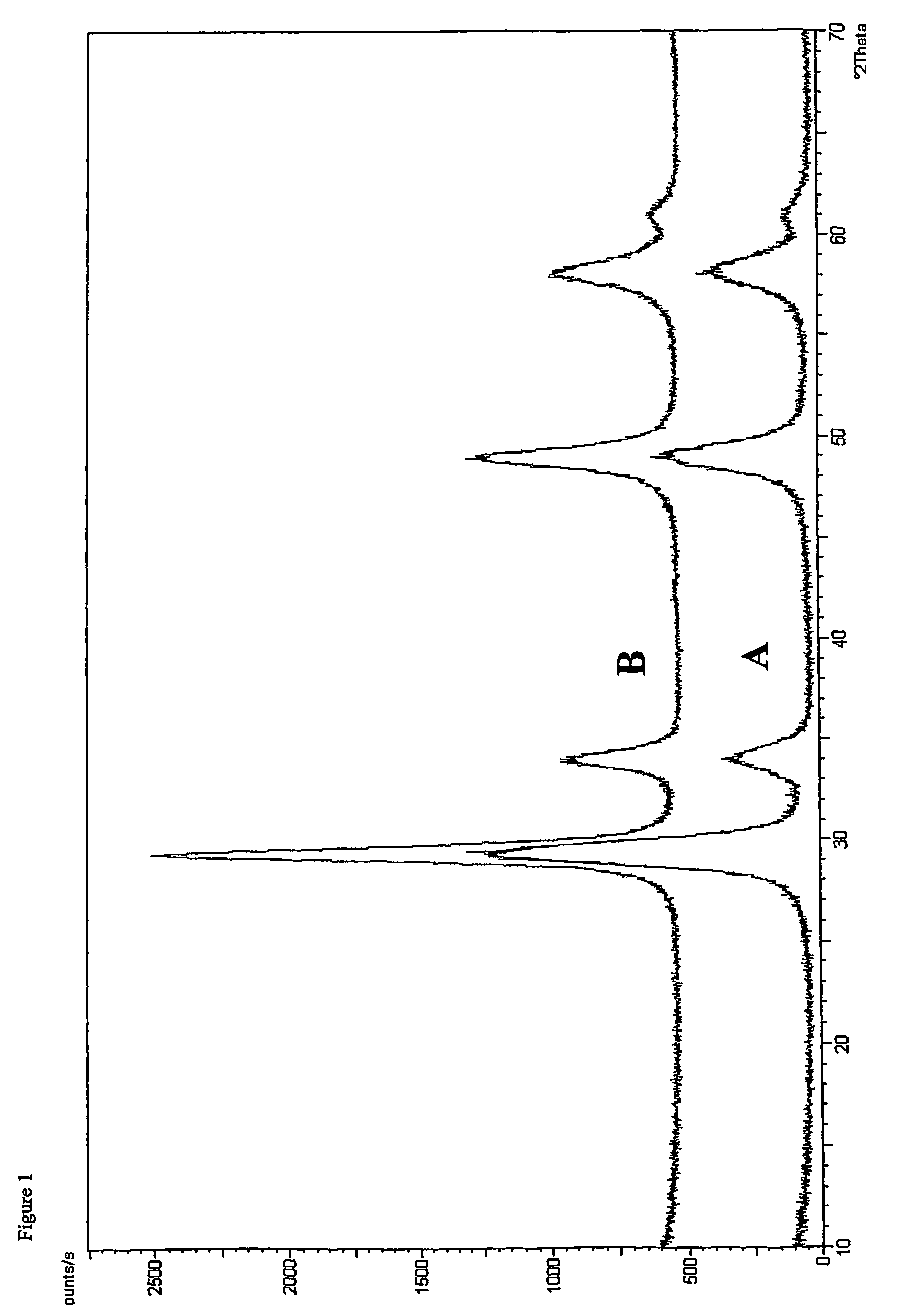Process for preparing zirconium-cerium-based mixed oxides
a technology of cerium-based mixed oxides and zirconium, which is applied in the direction of catalyst activation/preparation, metal/metal-oxide/metal-hydroxide catalysts, etc., can solve the problems of difficult to obtain single crystal phase, and narrow range of compositions which can be prepared. , to achieve the effect of easy filtration and washing, good thermal stability and homogeneous crystal phase on a commercial scal
- Summary
- Abstract
- Description
- Claims
- Application Information
AI Technical Summary
Benefits of technology
Problems solved by technology
Method used
Image
Examples
example 1
[0044]A mixture of 234 g of an aqueous solution of zirconium oxychloride (20 wt % ZrO2) with a molar ratio (Cl / Zr) of 2, 213 g of an aqueous solution of cerium nitrate (25 wt % CeO2) and 219 g of an 8.6 wt % aqueous solution of sulphuric acid (corresponding to SO42− / Zr4+=0.5 / 1) was prepared, and a 10 wt % aqueous solution of NaOH was added dropwise to the mixture with stirring. A white precipitate formed by the time when the pH reached approximately 1.5. The precipitate was confirmed by observation with the scanning electron microscope to be composed of secondary particles with an average particle diameter of approximately 0.2 μm, which were composed of primary particles with a particle diameter of approximately 0.04 μm.
[0045]While continuing the stirring and maintaining the temperature of the reaction system at 40° C. or lower, the dropwise addition of the 10 wt % aqueous solution of NaOH was continued until the pH became approximately 8. At this point, a 30 wt % aqueous solution o...
example 2
[0050]A zirconium—cerium-based mixed oxide was prepared as in the aforementioned Example 1 except using 219 g of an 11.06 wt % aqueous solution of sulphuric acid (corresponding to SO42− / Zr4+=0.65 / 1) in place of 219 g of an 8.6 wt % aqueous solution of sulphuric acid (corresponding to SO42− / Zr4+=0.5 / 1).
[0051]The BET surface area (JIS R 1626) determined on the specimen obtained after heating at 950° C. for 2 hours as in Example 1 was 26 m2 / g.
[0052]Also, the X-ray diffractometry performed as in Example 1 indicates that the specimen heated at 950° C. for 2 hours in this Example 2 was composed of a single crystal phase.
example 3
[0053]One hundred grams of zirconium—cerium-based mixed oxide (ZrO2, 47 wt %; CeO2, 49 wt %; La2O3 4 wt %) was prepared as a pale yellow powder as in Example 1 except using a mixture of 235 g of an aqueous solution of zirconium oxychloride (20 wt % ZrO2) with a molar ratio (Cl− / Zr4+) of 2, 196 g of an aqueous solution of cerium nitrate (25 wt % CeO2), 22 g of an aqueous solution of lanthanum nitrate (18.2 wt % La2O3) and 213 g of an 8.8 wt % aqueous solution of sulphuric acid (corresponding to SO42− / Zr4+=0.5 / 1).
[0054]The BET surface area (JIS R 1626) determined on the specimen obtained after heating at 950° C. for 2 hours as in Example 1 was 39 m2 / g.
[0055]Also the X-ray diffractometry performed as in Example 1 indicated that the specimen heated at 950° C. for 2 hours in this Example 3 was composed of a single crystal phase.
PUM
| Property | Measurement | Unit |
|---|---|---|
| temperature | aaaaa | aaaaa |
| particle diameter | aaaaa | aaaaa |
| BET specific surface area | aaaaa | aaaaa |
Abstract
Description
Claims
Application Information
 Login to View More
Login to View More - R&D
- Intellectual Property
- Life Sciences
- Materials
- Tech Scout
- Unparalleled Data Quality
- Higher Quality Content
- 60% Fewer Hallucinations
Browse by: Latest US Patents, China's latest patents, Technical Efficacy Thesaurus, Application Domain, Technology Topic, Popular Technical Reports.
© 2025 PatSnap. All rights reserved.Legal|Privacy policy|Modern Slavery Act Transparency Statement|Sitemap|About US| Contact US: help@patsnap.com


